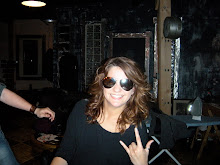When using graffiti as medium to instigate change, it has a very strong impact. Mostly because it is seen widely by people in the area, and it is in a more urban format which relates to a lot of people. It has always been seen as something that was illicit and criminal, where kids would just tag everything and anything they saw. Now graffiti is seen as an art form and people are using that to their advantage. Most of the graffiti that is produced in order to provoke people's thoughts are very direct, to the point statements or questions. One example is an unknown artist who has written "If you die today will you go to heaven?", "I don't feel like an ant but I sure look like one" (which comments on the population as a whole and our perception of individuality versus the whole) and "STOP Buying" - it was a stop sign with the word 'buying' spray-painted underneath the word STOP. The last one seems to me to be the most relevant since it deals with consumerism and our societies priorities.
The second way in which graffiti has changed into an activist movement is the way in which people are dealing with it in residential areas. A friend of mine who is in Police Foundations at Humber's Lakeshore campus was involved in 'The Croft Street Graffiti Project", where they went to a residential neighbourhood to paint over the graffiti that was bothering the residents. They hired artists to design murals and more 'family friendly' graffiti designs to go over the walls they were repainting. This was an initiative that they took in order to improve the environment around them, and to contribute to the neighbourhood that some of their classmates came from. I was really proud of him for taking the initiative to make something a little bit better, even if he didn't have to do much.
It just goes to show you that a little bit of paint can do so much; it can be harmful, it can be insightful, or it can be inspirational. It's all in how you use it.
